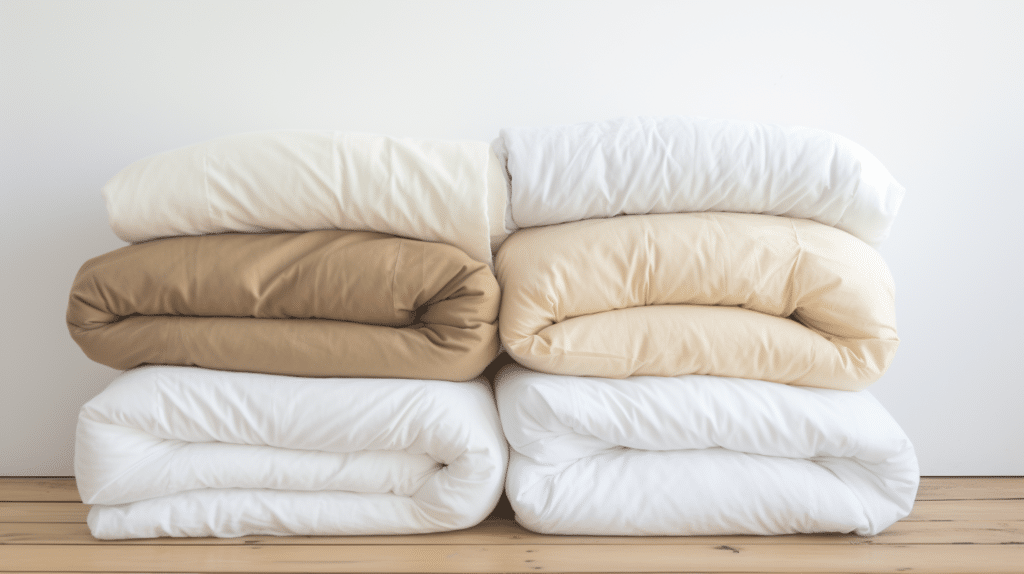Last Updated on August 3, 2023
Choosing the perfect duvet can be a daunting task, but understanding the importance of tog ratings can greatly simplify the process. Tog ratings indicate a duvet’s thermal insulation performance, allowing you to find the ideal balance of warmth and comfort to suit your individual needs. With a variety of options available, it’s essential to consider not only the tog rating, but also the duvet fillings, sizes, and weights, as well as any special considerations that may be relevant to your specific situation.
To start, it’s important to understand the basics of tog ratings. They range from lightweight options, such as a 4.5 tog duvet suitable for summer months, to a heavier 13.5 tog duvet ideal for winter. While the actual numbers may seem complex, the essential thing to remember is that a higher tog rating will offer more insulation and warmth. However, the level of warmth depends on the type of filling used, which can greatly impact the overall effectiveness of the insulation.
As you explore different duvet options, you should also pay attention to the sizes and weights, as they can significantly affect your overall comfort. Don’t forget to consider any allergies or preferences for natural or synthetic fillings as well. While diving into the world of duvets might feel overwhelming at first, it’s easy to make an informed decision when you understand how tog ratings, filling materials, and other factors play a role in your ultimate comfort.
Key Takeaways
- Tog ratings indicate the thermal insulation of a duvet, helping you find the optimal balance of warmth and comfort.
- The effectiveness of insulation depends on the type of filling used, so consider your preferences and any allergies in your decision.
- Keep in mind duvet sizes, weights, and other factors when choosing the right duvet to ensure maximum comfort for your specific situation.
Understanding Tog Rating
What is a Tog Rating?
A tog rating is a unit used to measure the warmth or thermal resistance of a fabric, and it is commonly used to rate the insulation of duvets. The higher the tog rating, the warmer and more insulating the duvet will be. Tog ratings typically range from 1 tog for the coolest duvets to 15 tog for the warmest ones.
The scale is based on the thermal resistance and insulation properties of a duvet’s material, meaning that tog ratings not only affect the temperature but also the weight and softness of the duvet.
Relevance in Duvets
Tog ratings are crucial when choosing a duvet, as they determine how well a duvet will keep you warm and comfortable throughout the night. A proper tog rating ensures that you get the right level of warmth for your sleeping environment and personal preferences.
It’s essential to choose a duvet with the appropriate tog rating to regulate your body temperature properly and maintain a comfortable sleeping environment during different seasons of the year.
Seasonality
Duvets with different tog ratings are suitable for various seasons, allowing you to choose the right duvet based on the time of year and the temperature.
- Summer: Lighter duvets with a tog rating of 2.5 to 4.5 are perfect for warmer summer nights, as they provide enough insulation without causing overheating.
- Spring and Autumn: Moderate temperatures call for duvets with tog ratings of 9 to 11.5, ensuring you stay warm and comfortable during these transitional seasons.
- Winter: Cold winter nights require a higher tog rating, typically around 13.5. These warmer duvets provide excellent thermal insulation, retaining heat and ensuring a cosy night’s sleep in chilly conditions.
By understanding tog ratings and how they relate to duvets’ warmth and thermal insulation properties, you can make more informed choices to achieve a comfortable and restful sleep throughout the year.
Choosing the Right Tog Rating
Lightweight Tog Ratings (1-7)
A lightweight duvet with a tog rating between 1 and 7 is ideal for warmer seasons such as spring and summer. These duvets are less insulating and allow for better airflow, ensuring a comfortable sleeping temperature. Lightweight duvets commonly have a tog rating of 4.5, making them perfect summer duvets.
Some benefits of lightweight duvets include:
- Better airflow and breathability
- Suitable for hot sleepers or those with night sweats
- Ideal for spring and summer months
Medium-Warm Tog Ratings (8-11)
Medium-warm duvets, with tog ratings between 8 and 11, provide a balance of warmth and breathability. A 10.5 tog duvet is ideal for spring and autumn when the temperature starts to fluctuate. This tog range offers versatility and can be suitable for those who prefer a slightly warmer duvet during the summer months or a cooler duvet in winter.
Key features of medium-warm duvets include:
- Balanced warmth and ventilation
- Suitable for in-between seasons
- Versatile for various sleeping preferences
High Tog Ratings (12-15)
For colder months such as winter, a high tog rating duvet (12-15) is the preferred choice. These duvets provide excellent insulation, ensuring maximum warmth during the coldest season. A 13.5 tog rated duvet is a popular option, while those who prefer even more warmth can opt for a 15 tog winter duvet.
Benefits of high tog rating duvets are:
- Superior insulation during cold weather
- Keeps you warm and cosy
- Ideal for winter months
When choosing the right tog rating for your duvet, consider factors such as the season, your preferred sleeping temperature, and the desired level of warmth and comfort. By selecting the appropriate tog rating, you can ensure a good night’s sleep all year round.
Duvet Fillings
When choosing a duvet, the filling plays a crucial role in determining its comfort, warmth, and longevity. In this section, we explore two primary types of fillings: natural and synthetic.
Natural Fillings
Natural fillings include materials such as cotton, wool, silk, bamboo, and feather and down. These materials offer various benefits that contribute to a comfortable and cosy sleep experience.
- Cotton: Cotton-filled duvets are breathable, soft, and hypoallergenic. They are ideal for those with sensitive skin or allergies.
- Wool: Wool is an excellent natural insulator, providing warmth in the winter and staying cool during summer nights. Wool-filled duvets are also moisture-wicking, making them suitable for those who tend to sweat during the night.
- Silk: Silk duvets are lightweight and soft, with good temperature-regulating properties. They provide a luxurious feel and are ideal for those looking for a touch of indulgence in their bedding.
- Bamboo: Bamboo-filled duvets boast sustainable and eco-friendly credentials. They are hypoallergenic, breathable, and have excellent moisture-wicking properties.
- Feather and Down (Duck Feather, Hungarian Goose Down): Feather and down duvets offer exceptional warmth and insulation. Duck feather duvets provide a cost-effective option, while Hungarian goose down duvets offer the ultimate in luxury and warmth.
Synthetic Fillings
Synthetic fillings, such as microfibre and polyester, are an alternative to natural fillings. They cater to various budgets and preferences while offering benefits such as easy maintenance and hypoallergenic properties.
- Microfibre: Microfibre duvets mimic the feel and warmth of down but at a more budget-friendly price. They are lightweight, soft, and low maintenance, making them suitable for those with busy lifestyles.
- Polyester: Polyester-filled duvets are lightweight, machine washable, and quick to dry. They offer a cost-effective option for those on a budget, without compromising on comfort.
In conclusion, both natural and synthetic fillings have their benefits. The choice between them will depend on individual preferences, budget, and specific needs. When selecting a duvet, consider factors such as warmth, breathability, and maintenance, as well as any guarantee offered by the manufacturer.
Important Factors to Consider
When selecting a duvet, it’s essential to consider a variety of factors to ensure your bedding is comfortable, cosy, and suitable for your needs. One key aspect is the duvet tog rating, which represents the duvet’s thermal insulation abilities. Tog ratings range from 2 (lightest) to 15 (warmest), and finding the appropriate rating can make a significant difference in achieving a good night’s sleep.
Room temperature and weather often play an important role in choosing the right duvet. By taking into account the climate and time of year, you can make a more informed decision. Cooler seasons may require higher tog ratings, while warmer months would benefit from lower togs.
Furthermore, personal preference and your partner’s sleeping habits should be taken into consideration when selecting a duvet tog rating. Some people may prefer a lighter duvet even in colder months, while others might enjoy a heavier one during warmer seasons.
Allergies and health concerns are also essential factors. Hypoallergenic materials can help minimise allergens’ impact and contribute to a healthier sleep environment. Consider investing in a hypoallergenic duvet if you or your partner are prone to allergies, ensuring a more restful and comfortable sleep.
When it comes to children’s bedding, safety is crucial. Young children, especially those under 12 months, should not use duvets due to the risk of suffocation. As children grow older, choose a suitable tog rating to avoid overheating. Consult guidelines for choosing the appropriate duvet for children over 3 years old.
Other factors to keep in mind include the size of your bed – whether it’s a king-size or other variations – and UK sizes of duvets when purchasing. Also, consider the durability, thread count, and ease of care for your chosen duvet. High-quality materials and construction will ensure longevity, with some options being more breathable and easier to maintain.
Lastly, don’t forget to evaluate your budget and the additional bedding elements you may need, such as pillows and mattress protectors. By taking these factors into account, you’ll be better equipped to create a comfortable and inviting sleeping environment tailored to your needs.
Duvet Sizes and Weights
When choosing the perfect duvet, it’s essential to consider not only the right size but also the appropriate weight for your needs. Factors like bed size, preferred warmth, and whether it’s machine-washable can play a significant role in your selection process. This section focuses on helping you make an informed decision regarding duvet sizes and weights.
UK Duvet Sizes
In the United Kingdom, duvets come in various sizes, matching different bed dimensions. Here are the standard UK duvet sizes:
- Cot: 120cm x 150cm, suitable for a cot or a small bed for infants.
- Single: 135cm x 200cm, designed to fit a single bed comfortably.
- Double: 200cm x 200cm, suitable for a standard double bed.
- Super King: 260cm x 220cm, the largest option, designed for a super king-size bed.
Understanding these standard sizes is crucial in ensuring your duvet fits your bed comfortably and provides the desired warmth.
When it comes to weight, different duvets have varying fill weights, which essentially measures the amount of filling inside the duvet. This factor, combined with the duvet’s tog rating, determines the overall warmth provided by the duvet. Fill weight is particularly essential for individuals who are sensitive to temperature changes or suffer from allergies, as it can significantly impact your sleeping experience.
It’s also important to consider whether the duvet is machine-washable. Many modern duvets are designed to be easily cleaned using a washing machine, but some may require special care, such as professional laundering or dry-cleaning. Be sure to check the manufacturer’s recommendations when purchasing and caring for your duvet to ensure its longevity.
By taking into account the various factors such as standard UK duvet sizes, fill weight, and the preferred tog rating, you can choose the perfect duvet that suits your requirements and enhances your sleeping experience.
Special Considerations
When selecting a duvet tog, there are a few special considerations to keep in mind, such as the needs of hot sleepers, children, toddlers, and the various duvet fillings available. Additionally, factors such as caring for your duvet and the role of throws and quilts should also be taken into account.
Hot sleepers often require a lower tog duvet to ensure they stay cool and comfortable throughout the night. The Duvet Tog Guide recommends lighter tog options, typically between 2.5 and 7.5, to better regulate their body temperature.
For children and toddlers, safety and comfort are paramount. It is essential to select the right tog to ensure they do not become too hot or cold during the night. The Dormeo UK’s Duvet Tog Guide suggests using a 4.5 tog duvet for toddlers and a 7.5 to 10.5 tog duvet for older children.
Duvet fillings play an important role in determining the comfort level of your duvet. How To Choose The Best Duvet Guide explains that popular fillings like down and feathers provide warmth, breathability, and lightweight properties, while synthetic fillings such as microfiber and hollowfibre are more affordable and easier to care for.
Throws and quilts can be utilised to further customise your sleep environment. They can add an extra layer of warmth when necessary or be used instead of the duvet on hot summer nights.
Duvet maintenance is crucial to prolong the lifespan of your duvet and maintain its quality over time. Make sure to follow the care instructions provided by the duvet’s manufacturer. This can include airing out the duvet regularly, washing according to guidelines, and properly storing during off-seasons.
In conclusion, keep these special considerations in mind to make an informed decision when selecting the ideal duvet tog for your specific needs.
Frequently Asked Questions
What is the appropriate tog rating for a winter duvet?
A winter duvet typically has a higher tog rating to provide more insulation and warmth. Generally, a tog rating of 13.5 or above is considered suitable for a winter duvet, retaining heat more effectively in cold nights.
How do tog ratings vary for children’s duvets?
Children’s duvets usually have lower tog ratings to prevent overheating and ensure comfort. It’s recommended that toddlers and young children use a 4.0 or 4.5 tog duvet, as it provides adequate warmth without being too heavy.
Which tog rating is suitable for a summer duvet?
A lower tog rating is ideal for a summer duvet, as it will be lighter and more breathable. A 4.5 or lower tog rating is generally recommended for warm summer months, ensuring a comfortable and cool sleep.
How does tog rating differ for king size and double size duvets?
Tog ratings don’t differ for king size and double size duvets, as it is a measure of the duvet’s thermal insulation. The major difference between these duvets is their size, with king size duvets being larger than double size duvets.
Can a 10.5 tog duvet be used in winter?
Yes, a 10.5 tog duvet can be used in winter, especially if you prefer a lighter duvet or live in a well-insulated house. However, for extremely cold conditions or if you feel cold easily, you might consider opting for a higher tog rating.
Is a 4.5 tog duvet sufficient for colder months?
A 4.5 tog duvet is generally considered suitable for the warmer months and might not provide enough insulation for colder months. If you require more warmth, you may want to opt for a higher tog rating or use additional blankets during cold nights.



